#(ill make actual cabby art at some point!!!! i just needed to pinpoint the design thats been vaguely floating around in my head)
Explore tagged Tumblr posts
Text
04.23.24
🗄️

#(i made this during lesbian visibility week#i dont know if itll still be that when this posts)#cabby ii#ii cabby#ii fanart#inanimate insanity invitational#inanimate insanity#(ill make actual cabby art at some point!!!! i just needed to pinpoint the design thats been vaguely floating around in my head)#(which is harder than one would expect)
10 notes
·
View notes
Text
The lying liars who lie
Years and years late to the party, I’ve finally gotten my hands on all the DVDs of BBC Sherlock, and I thought it would be fun to watch the extra material carefully, one piece after another, and also listen to at least some of the show makers’ commentary of the episodes. But at this point, after S4 where DVDs seemed to be a constant lying device in general, I tend to look at them with a bit more suspicious eyes...
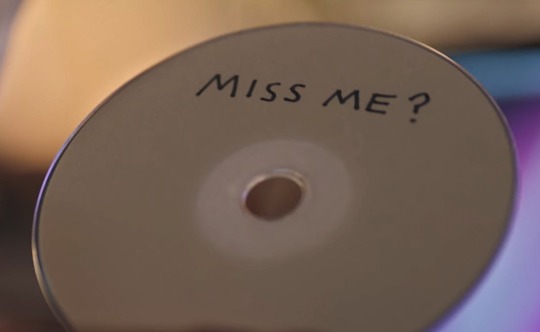
I still love the show of course, but now that I’ve taken this deep dive into all the special features, I find them a truly hard thing to try to wrap my head around. Even this long after the fact, I’m amazed by the amount of shameless, self-congratulatory BS in the DVDs, where the people involved can’t have enough of complimenting each other and their show, while they skillfully avoid to discuss anything actually meaningful about the plot line. ;) For example, Moffat claims in the S2 DVD that “In fact, you’ll never see a more obsessively authentic version of Sherlock Holmes than this one”. But if we follow their light-hearted commentary, which basically takes the show at face value, I’d call that not just hyperbole, but an outright lie. If you want to see the ‘authentic’ stories from ACD’s work in this show, you’ll definitely need to go much deeper into the subtext and meta levels - neither of which are mentioned on these DVDs of course. Here’s my own (rather subjective) ‘review’ of the whole thing, trying to pinpoint why I view most of the commentary of the show from its own makers as an advanced art of deception.
(My musings under the cut)
Series 1 - a wealth of extra material
First of all - as many of you probably knew already - the whole of the Unaired Pilot is added to the DVD of S1. In the extra material about the making of the series, they (Sue Vertue, Mofftiss and others) talk about what things they changed between the Pilot and ASiP, claiming that many changes were necessary improvements once they knew that they had a whole series and a lot more time at their disposal.
Which I can perfectly understand and agree with in general. But I think what’s missing in their discussions is more interesting than what’s actually there (”Mind the gap” ;) ). Things that I would expect from the show makers when they go to the trouble of comparing the pilot version with the aired product. There’s not a word, for example, about the fact that they added both Mycroft and Moriarty to the story in ASiP - two characters who later turn out to play major roles and appear in almost every other episode until the end of TFP. Or about the choice that one of the screenwriters would play Mycroft.
Neither do they discuss why they chose to relocate the place where Sherlock was challenged by the cabbie from 221B to Roland Kerr’s School of Further Education. Instead they focus on the details, like for example the new design of the interior of 221B.
Not to mention the fact that almost every scene in the Pilot is mirrored in ASiP (as pointed out long ago by @kateis-cakeis X), but at Angelo’s in the Pilot Sherlock follows the events with the cabbie while looking in an actual mirror. I even noticed that in the Pilot the cabbie is offering Sherlock dark-coloured bottles with the pills in them, while in ASiP those bottles are transparent, as if the cabbie is offering Sherlock to play Black or White in the chess game that he is simulating. What’s with all these mirrors, though? Not a word on the DVD... ;)
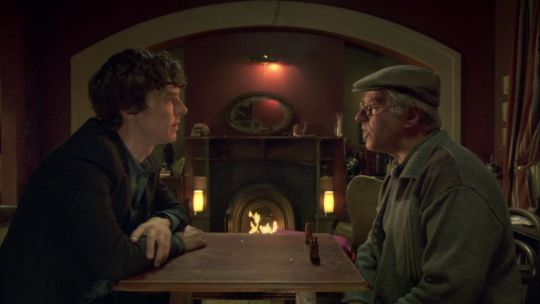
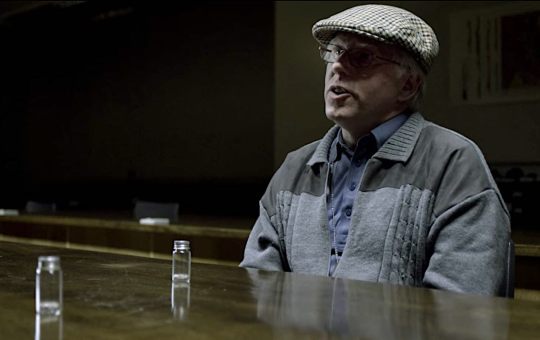
Now, even though these rather remarkable choices are neglected together with a great bunch of minor ones, I still think that the most interesting fact about all this is that they actually included the whole pilot version within this DVD, which is sold by the franchise. Why even do this, when it raises far more questions than it answers? The only logical reason I can come up with is that they’re laying out a track of little hints that anyone with a deep enough interest in the show to actually buy the DVDs can try to follow. And it seems to me that lying by omission is one of the first steps in the long line of cryptic and misleading author comments on this show. But at the same time, they clearly want the fans to have access to it all, even the abandoned version.
Moving on to Series 2, time for bigger lies
In the extra material of this DVD Benedict himself describes how his character "faces one of his deadliest enemies in the shape of Love, and it comes in the form of Irene Adler, who is this extraordinary dominatrix [insert here a bunch of superlatives regarding Adler]...”. And then we see how Adler whips Sherlock with a riding crop (without any kind of consent, I have to add) while he’s lying on the floor, and we have Lara Pulver telling us how it was to have a go at Benedict on set. So Holmes whips dead bodies and Adler whips living; seems like a match made in hell! :))
Gatiss claims, grinning with his whole face, that “they’re clearly, absolutely made for each other”. OK, so I think we can see Sherlock being intellectually impressed by Adler, and even trying to protect her from Mycroft, and we can see John acting jealously. We can also see her being dressed and styled as a perfect, female mirror of Sherlock. But I’m still at a loss what all this has to do with love on Sherlock’s part? Especially since he’s not even responding in any fashion to her various attempts at seducing him.
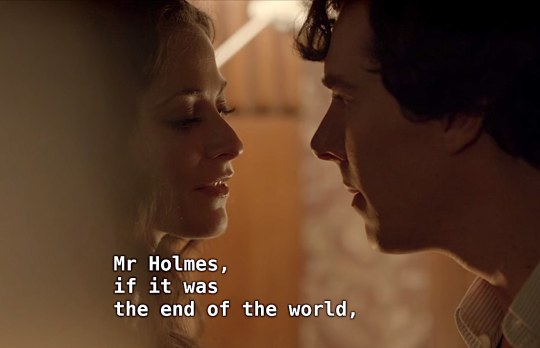

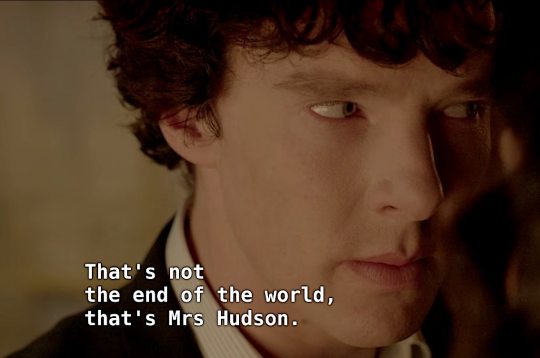
And there’s more: Paul McGuigan, the director of ASiB, claims that the scene where Sherlock has a conversation with Adler inside his Mind Palace about the crime case with the car that backfires "is a part of a kind of love story, if you like...” No, I don’t. Maybe it’s just me, but if their aim really was to convey to their audience a love story between Sherlock and The Woman, I think they failed miserably. All I see is a guy ’mansplaining’ to a clever woman how to use her brain, while she’s trying to flirt with him by expressing her admiration (to no avail, though) and make deductions at the same time. Nothing new under the sun, really. John did the same thing repeatedly in ASiP (without making own deductions) and got far more attention from Sherlock, but I’ve never heard any of the show makers call that ”a love story”. But by ’lie-splaining’ the scene with Irene to the audience, they try to manipulate us all to see it as such...
In all the direct commentary of this episode, where Steven, Mark, Sue, Benedict and Lara are present, I get the impression that every time they even touch on the relationship between Sherlock and John, they hurry to add the term “friendship” or “man love” or similar words in case they forgot them at first, avoiding even the tiniest possibility that there could be anything more going on between them. They even explain that when Irene calls them “a couple” she does not mean anything romantic. This whole approach feels almost paranoic in the midst of all the laid-back jokes and light-hearted talk about the filming. It’s as if a sort of restrictive, heteronormative filter or blanket is being constantly applied, to teach the audience the ‘no homo’ lesson of it all. And the more I listen to this, the more tiresome it becomes.
In the commentary Moffat does reveal an interesting detail, though: that the ‘Flight of the Dead’ in ASiB was inspired by a cut out scene in the Bond movie On Her Majesty's Secret Service. To me this is just one more reason to question the ‘authentic’ quality of this scene, as opposed to possibly taking place in Sherlock’s Mind Palace. But I digress...
Listening to the commentary in general, it’s like it’s aimed to distract the attention from what’s going on at the screen rather than highlight it and try to explain their intentions. They do mention that Irene didn’t actually ‘beat’ Sherlock in the end of ASiB, but there’s no explanation of this obvious deviation from canon, where Adler does indeed fool Holmes, taking advantage of his prejudices.
The rest of the extra material of S2 is mostly about technical stuff, special effects and such, and also about filming techniques and Benedict’s delivery of fast deductions. But the part I really do love is the one where Andrew Scott talks about how much he enjoyed playing the scene where Moriarty dances before breaking into the Crown Jewels. That’s one of my favorite scenes of he whole show. :) Also, the takeaway message from this DVD is Moffat’s words at the end:
“These are still the formative years of Sherlock Holmes, and the most important thing about this series is not that it’s updated; it’s the fact that those two men are still young and they’re still at the beginning of what they don’t yet know is gonna be a lifelong partnership”.
And then comes Series 3...
...and its extra material, with the most blatant attempts at deception so far, I believe. At this point Sherlock is called a “psychopath” by both the show’s characters, John’s blog, Benedict Cumberbatch and Martin Freeman as if it were true, which is a big deviation from ACD canon. That simply doesn’t happen there; while Holmes is sometimes described as eccentric, no one in the books is ever claiming that Sherlock Holmes has some kind of mental illness leaning towards cruelty and egotism - not even his enemies say this about him. In the show, however, they begin in ASiP with making him torture a dying man for information (something that is not included in the Pilot). And in S3, where they avoid discussing the reason why they turned Mary Morstan into a ruthless assassin, this major shift is glossed over by the fact that in the same episode (HLV) they also turn Sherlock into a murderer, who cold-bloodedly blows the brains out of a blackmailer for threatening to make said assassin’s crimes public.
But without ever getting into the “why” of it all, the cast and crew seem overly happy and smiling describing these rather morbid choices as something positive; “fantastic”, "fresh and new” and "amazing” are their choice of words. Benedict claims that Mary, who has literally shot and almost killed Sherlock in HLV, is now "a new best friend of Sherlock’s”. Amanda claims that Mary “is protecting John” when she shoots Sherlock in the chest. Now they’re both psychopaths, and poor little John is forced to stomach them both because he’s addicted to danger. In Amanda’s words, Mary also “kind of gets in between the two of them, but she wants them to be together as well”. Which is a load of BS considering that Mary tries to kill the protagonist of the story.
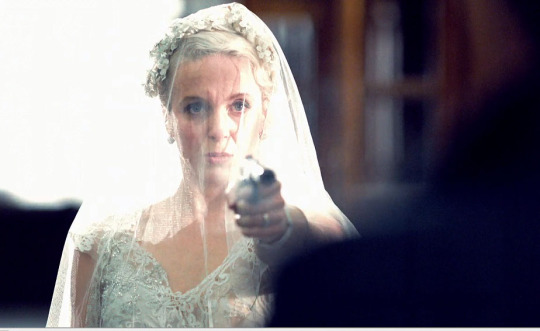
Lars Mikkelsen thinks it’s “such a good script” because “you’re mislead as an audience”. But he never gets the chance to expand on what the misleading actually contains, because then Mofftiss cut in to express how much they love playing with “what ifs”. As if this whole mega-budget project of a show were just a big experimental playground without any actual story to tell.
Benedict repeats his line from HLV that Magnussen “preys on people who are different” and Moffat also says he “exploits people who are different”. Which is really confusing, considering what we can see Magnussen actually do in the show. Lady Smallwood and John Garvie are two well-established, powerful governmental politicians whom Magnussen blackmails by finding their respective pressure points. In Garvie’s case his pressure point seems to be alcohol problems in his past, but according to media he’s later arrested on charges of corruption. Lady Smallwood is blackmailed on the basis of her husband having sent compromising letters to a minor many years ago, in spite of later claiming that he thought she was older and stopped when he found out the truth. And then Magnussen is blackmailing an assassin who recently threatened to execute him but shot Sherlock Holmes instead, in order to try to get at Sherlock’s brother Mycroft, another powerful governmental figure.
But what does media seeking out dirt on certain people in power and their families have to do with “people who are different”? Despicable as the method may be, isn’t this unfortunately how political power play usually works in our society? Or are TPTB somehow a repressed minority group now? Unless this whole “people who are different” accusation is actually about something entirely different, something that none of the show makers even cares to mention... ;)
In these DVDs, none of the involved persons is ever discussing the change of roles with regards to canon, though, or the (lack of) logics in this turn of events, or even a hint about the narrative motivation behind them. It’s all about the great Drama, the extraordinary visual effects and the aim to endlessly “surprise the audience”. Which is fine by me to a certain extent, but when this is all that’s being said, it feels extremely superficial, as if the audience is merely seen as a bunch of consumers that have to be triggered more and more by horror, special effects and cliff hangers to be able to appreciate the show. (“Warm paste” indeed, like Gatiss has later criticized some viewers of wanting...) While the "why”; the idea behind this surrealistic adaptation, made by self-proclaimed fanboys of ACD, is not even touched upon. Around this, the silence is total and therefore totally confusing.
Maybe I shouldn’t even go into Series 4...
...but why not, since I’ve already started? :)
First of all, there’s a lot of extra material on this DVD and I particularly love the parts about the music and composing and Arwel Wyn Jones’ work with the design and build-up of John’s and Mary’s flat and the interior of 221B. Those bits are truly enjoyable. What I could live without, though, is the leading commentary that kind of instructs us, the audience, how we should interpret the show.
Benedict is on it again on this DVD, telling us that in TST they picked up where they left off in S3 and “It’s a very happy unit of three people that then become four.” Why does he feel the need to make this statement, considering how S3 ended? Actually, if there’s anything I totally fail to see in S4, it’s happiness. The banter between the three of them may seem entertaining for a while, but who could have a relaxed, warm relationship with someone who tried and almost succeeded to kill you less than a year ago? Without any sign of remorse? Now there’s a dark tone of discomfort and mean jokes that feels forced and not even a bit happy to me.
But Martin tells us how excited John and Mary are about starting a family and Amanda mentions how much they’re looking forward to the baby. Again and again it’s repeated, as though trying to rub it in: “they’re in a good place, they’re a loving, married couple”. Yeah, right - a child that (judging by TSoT) wasn’t at all planned and now with an assassin for a mother... Twice we see the new parents complain that their daughter has the mark of Satan on her forehead and debate which horror movie she’s from. The clichéd hypocrisy of it all is sickening, and I’m willing to bet that it’s really meant to be. ;)
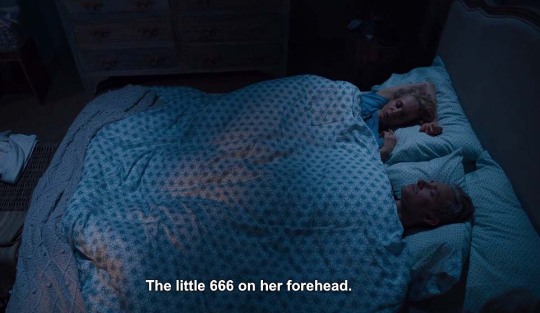
But Gatiss chimes in, deciding for us all that the christening of Rosie is “a funny scene” and “they’re enjoying each other, enjoying being on adventures as a three”.
An interesting detail is that Gatiss also tells us that the working name of this episode was “The Adventure of the Melting power Ranger”. So this little blue guy was that important? :) And - even more interesting - is when he says: “Cake is now the code for violent death”. So how should we interpret Sherlock, John and Molly going out to have cake in TLD then, on Sherlock’s (supposed) birthday?
These might be jokes, though, but when they tell us that Sue cries every time she sees Mary’s death I strongly believe they must be joking. How could anyone feel truly moved by this overly sentimental long monologue where far more efforts are put into reacting to Mary’s speech than saving her life? And John’s mooing like a cow, is that also moving? :)
One thing Martin says about TLD that actually disgusts me is regarding the morgue scene where John assaults Sherlock and Sherlock lets it happen: “From there, really, their relationship can only sort of rebuild, that’s the absolute worst it can get”. As if outright physical abuse would be something that makes you want to rebuild a relationship? Wow - just wow... How far can they go with this crap?
Anyway, when we finally arrive at the absurdity of TFP and Sherlock’s ‘secret sister’, everything is of course discussed as if she actually does exist on the given premises, and everything she does is ‘real’, no matter how impossible it would be in real life. The abandonment of any attempt to have the story line make logical sense is skillfully covered up by more distraction with fascinating technicalities of the film making process. This is where Gatiss makes his now almost classic statement that after Sherlock and John jump out of the window at 221B when a grenade explodes there, it’s just “Boop! And they’re fine.”
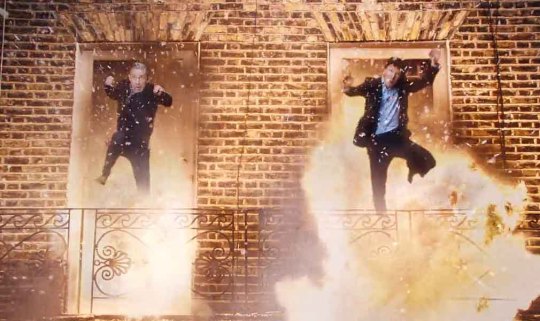
Of course there’s no serious attempt at explaining this logically. Except perhaps Gatiss claiming that they both landed on Speedy’s awning - whatever good that would do to them, since the awning is leaning downwards, but never mind... But we never even saw that happen, did we? A great deal of time is then dedicated to show all the precautions to have Martin and Ben jumping safely at low level onto a madras supported by empty cardboard boxes.
Sian Brooke did say something interesting about Sherrinford, however, that got me thinking. She said that Eurus “wants revenge for the years and years that she has been held captive” there, isolated, and that in TFP the Holmes children are now “lab rats” and “it’s an experiment”. On a meta level, I think we can indeed see this episode - and maybe the whole show - as a kind of experiment, but maybe we, the audience, are also lab rats? Since Sherrinford is slightly shaped like a film camera (not commented in the extra material, of course), it leads my thought to all the adaptations through the years and years where Holmes and Watson have not been allowed to be together. A whole century when Sherlock Holmes has been held captive, restricted by the very same sort of heteronormative filter that all this extra material imposes; it’s like Sherrinford, isn’t it? Which gives all the more meaning to Moriarty’s arrival to the island, accompanied by Freddy Mercury’s “I want to break free”...

I think I’ll let the final words in this little exposé come from Mark Gatiss in The Writers’ Chat (my bolding):
“Moriarty is a fascinating thing in that in our sea of ongoing lies, one thing we’ve genuinely been completely consistent about is telling people he’s dead. But no-one believes it! And it’s a rather brilliant thing.” Again - self-congratulatory statements. But instead of providing some actual evidence of the death of this character, who has kept popping up in almost every episode since his supposed demise, they think that the more a confirmed liar repeats something, the truer it gets? And the more we’re supposed to believe them? Well, all we can do is wait and see. :)
Tagging some people who might be interested:
@raggedyblue @ebaeschnbliah @sarahthecoat @gosherlocked @lukessense @sagestreet @thepersianslipper
My earlier meta on a similar topic (X)
225 notes
·
View notes